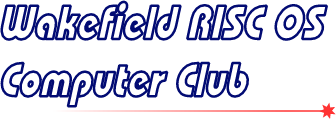Meeting: eBook Readers – Will They Replace Books?
Steve Bass investigated the subject of eBooks, with an introduction to what they are and the hardware required to read them. He covered a range of solutions – from dedicated readers to software for existing systems – before discussing the range of file formats and protection methods available. The evening closed with a look at the software available on RISC OS for reading eBooks or even creating your own.
Report by Steve Fryatt
June’s meeting saw Steve Bass posing the question: “eBook Readers – will they replace books?” The small hand-held devices have been making inroads into the book market in recent years, in no small part promoted by the Amazon Kindle – the question for those who haven’t yet encountered one in the flesh is whether they are a gimmick or here to stay.
Steve started by giving an overview of the book market into which the readers are trying to gain entry. Printed books haven’t changed much since Gutenberg worked out how to quickly produce pages of text in the 1400s. Into this stable world has come the electronics industry, but it’s not all plain sailing. The market is rather reminiscent of the music industry when Apple launched the iPod just over a decade ago: a confusing array of different and incompatible standards. Is it now the time to ditch the printed word and if so, what kind of ePaper should you pick?
What’s an eBook anyway?
The term ‘eBook’ is a pretty all-encompassing one which covers a wide range of formats and options. At its simplest, an eBook can be a PDF document: as Steve pointed out, the Club’s own newsletter and Back Catalogue can be argued to belong to the genre. The format is freely documented (issues of The WROCC are created using open-source software, for example), and Adobe has updated it to handle some of the more specific requirements of hand-held devices.
Formats for eBooks need to be compact, to allow many pages of text and graphics to be included on a single memory card. Although not always necessary, they ideally need to be able to allow their content to be ‘reflowed’ into whatever display format is available on a device (something that formats such as PDF have historically been unable to do). There is also a requirement for Digital Rights Management (or DRM), to prevent – or at least limit – the illegal copying of copyrighted works.
Although PDF can now meet these requirements, there are plenty of other options too. Open ones start with plain old HTML, although on its own it lacks compression which results in large file sizes. Many of the other formats are HTML- or XML-based, however, including OEBPS (or EPUB), created by the International Digital Publishing Forum. It’s popular as a vendor-independent solution, widely supported – although not on the Kindle – and allows for DRM. The Digital Accessible Information System (DAISY) is another open standard, with particular emphasis on accessibility for those with disabilities.
As one might expect, there are a wide range of proprietary formats. Sony have developed the Broadband eBook (or BBeB) format, although they have moved towards EPUB for new books. Compiled HTML was developed by Microsoft to provide online help under Windows ’98, taking standard HTML documents and compressing them together into a single file. Amazon have a range of Kindle formats; Microsoft offer the LIT format; Mobipocket have an eponymous format. Finally there’s DjVu, which is slightly different from the other formats as it’s aimed at compressing scanned text well.
Reading what’s written
There are a range of options for reading eBooks. Conventional desktop or laptop computers – running Windows, Linux, Mac OS or even RISC OS – are one option, if a little cumbersome for a book at bedtime. Tablets and smartphones have a range of apps available to read some of the formats. In both cases, exactly what formats are catered for will depend on the device and the OS that is running on it.
The other option is to use a dedicated eBook Reader. There’s a massive range of options out there beyond the familiar names like Kindle, Kobo and Nook: Steve’s list contained more than a dozen names. While the features they sport will vary, most readers have a display of 6" or more, a handful of simple controls, a battery and a few gigabytes of flash storage to hold the books that you wish to read.
The display is important: many readers use E Ink technology, which is both easier on the eye and less battery-hungry than backlit LCD. The downside is that many don’t have a built-in light (which would, of course, drain the battery); if you want to read one in the dark, you’ll still need the torch that you used for ‘old-fashioned’ paper books. Some readers have small keyboards, or even touchscreens.
Getting books into the reader is an important task, and how this is done varies widely. Cheaper models need a wired USB connection to a PC, possibly with the correct software at the other end. Most devices these days can connect wirelessly to a local network using WiFi; some can even use 3G mobile data connections, so that you can update your library while on the move.
Perhaps surprisingly, RISC OS users aren’t left totally out in the cold when it comes to eBooks. PDFs can be read directly using PDF or GView, and EPUB files can be read if they’re not protected by DRM. An EPUB file is just a container for a collection of other files, and is in fact just a Zip archive: it can be dropped on to SparkFS to open it up (or typed as &DDC and fed to InfoZip or similar). Inside will be various directories; some of these will contain HTML files that can be viewed in NetSurf. MOBI files can be converted to EPUB using Calibre on Windows or Mac OS.
Useful resources
There’s a range of useful resources on the internet for finding, converting and reading eBooks. Sources of free books include Google Books and Get Free EBooks; both provide free downloads, with the latter specialising in self-published works. Project Gutenberg is the daddy of open book sites, having been publishing out-of-copyright works since 1971; originally all of their titles were in plain text, but they’ve also added HTML and a range of modern eBook formats. Calibre’s website has a range of DRM-free books to download, and Luzme provides a search facility for titles on other sites.
Calibre itself is a piece of software (for Windows, Mac OS and Linux) which can be used to manage collections of eBooks, convert them between different formats (assuming that any DRM allows this to be done) and download them to readers. Another option is the Auto Kindle eBook Converter for Windows, which can turn a range of formats into the Kindle-friendly MOBI.
Some libraries are also starting to support eBooks. Wakefield don’t seem to have caught on yet, but Steve noted that residents of Leeds can borrow them for free with their library card: it can be done online and the books just disappear at the end of the loan period with no need to return them or pay the overdue fines! Bradford is currently investigating the possibility of supporting eBooks.
So will they?
The big question of the evening was whether eBooks will replace the traditional printed word. Steve’s answer was that it was probably a bit more complicated than that: eBooks are great, and provide access to a reasonably wide catalogue of books which are often cheap or even free if you know where to look.
On the other hand, he felt that the audience would agree that they’re not yet a perfect replacement for the printed page. Owning an eBook isn’t quite the same has having a hardback copy on your bookshelf, and in some situations a real book is easier to use.
Steve thought it was too early to say if eReaders would spell the end of the print medium. As with photographic film and vinyl records, it seems likely that people’s deep love of the physical form – and their resistance to change – will prevent paperbacks dying out completely, especially when it comes to specialist titles or limited editions. For the moment, he thought it best to see the eReader as a convenient companion that can replace some, but not all, of the books you buy. You may never want to ditch books altogether, but if you love to read it’s probably time to buy an eReader.
In fact that’s exactly what Steve did when he saw the Nook Simple Touch advertised for £29.







